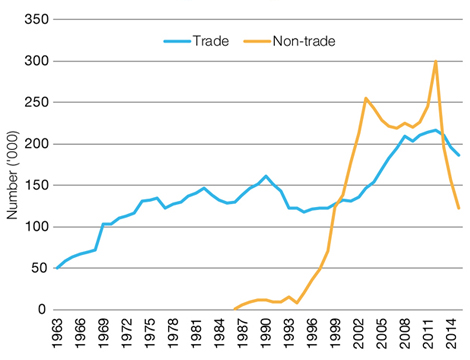If you’re running a vocational education and training organisation in Australia, you need to ensure that your organisation is compliant with government regulations. This article will outline some of the regulations that you need to be aware of, and provide tips on how to ensure compliance.
The Australian Skills Quality Authority (ASQA)
The Australian Skills Quality Authority (ASQA) is the national regulatory body for vocational education and training (VET) in Australia. They work according to set regulatory standards for quality education and training and their role is to ensure training organisations meet these standards. ASQA is the regulatory body for vocational education and training in the following states and territories:
- Australian Capital Territory
- New South Wales
- Northern Territory
- Queensland
- South Australia
- Tasmania
These jurisdictions are referred to as referring states and territories since they delegated their regulatory authority to the Australian Skills Quality Authority (ASQA) in 2011-12. Victoria and Western Australia are referred to as non-referring states because they have not yet delegated their regulatory authority to the federal government. ASQA is also in charge of regulating all Registered Training Organisations (RTOs) that provide courses to international students studying in Australia on student visas, regardless of where the RTO is based.
ASQA is responsible for regulating the quality of vocational education and training. ASQA audits training organisations to ensure they are complying with the VET Quality Framework and can take enforcement action if they find any non-compliance.
It governs RTOs in accordance with the Standards for Registered Training Organisations (RTOs) 2015 and approved courses in accordance with the Standards for VET Accredited Courses 2012.
For more information, please visit About us | Australian Skills Quality Authority (ASQA)
Victorian Registration and Qualifications Authority (VRQA)
In Victoria, the Victorian Registration & Qualifications Authority (VRQA) is the regulatory body for vocational education and training (VET), and it is in charge of the following:
- Training organisations that only provide training to domestic students in victoria.
- Accrediting courses, but only if the course is operated by the Victorian government or if the course owner is a Registered Training Organisation (RTO) that has been registered with VRQA.
VRQA regulates RTOs in accordance with The Australian Quality Training Framework (AQTF) – Essential Conditions and Standards for Continuing Registration and the VRQA Guidelines for VET Providers, and it regulates courses in accordance with The Australian Quality Training Framework AQTF 2007 Standards for Accredited Courses.
For more information, please visit VRQA
Training Accreditation Council – Western Australia
In Western Australia, the Training Accreditation Council (TAC) is the regulatory body for vocational education and training (VET), and it is in charge of the following:
- Training organisations that only provide training to domestic students in Western Australia.
- Accrediting courses, but only if the course is operated by the Western Australian government or if the course owner is a Registered Training Organisation (RTO) that has been registered with TAC.
TAC regulates RTOs in accordance with Standards for Registered Training Organisations (RTOs) 2015, and it regulates courses in accordance with The Australian Quality Training Framework AQTF 2007 Standards for Accredited Courses.
For more information, please visit Training Accreditation Council
Non-compliance with the regulatory standards and guidelines
If your organisation is non- compliant with the applicable standards and regulations, you could face penalties, such as fines or being shut down. Here are some important tips on how to stay compliant:
1. Make sure you’re registered with the appropriate regulatory body
The first step is to make sure your organisation is registered with the appropriate regulatory body. This means your organisation has met the minimum standards required to be registered and can offer courses that are nationally recognised.
If you’re not registered, you won’t be able to offer any nationally recognised courses and you will also face penalties if you are caught doing this.
2. Follow the General Directions, fact sheets, guides and tools
The regulatory bodies release a set of guidelines that organisations must follow in order to stay compliant. The General Directions, fact sheets, guides and tools cover everything from governance and management to teaching and assessment practices.
Make sure you’re familiar with the General Directions, fact sheets, guides and tools and are following their instructions and guidelines closely. This will help ensure your organisation meets the standards set by the regulatory bodies.
For more information, please visit Resources for providers | Australian Skills Quality Authority (ASQA)
3. Keep your records up to date
One of the most important things you can do to stay compliant is to keep your records up to date. This includes keeping track of your student’s progress, as well as your organisation’s administration, reporting, finances and governance.
The regulatory body may request to see your records at any time, so it’s important that they’re accurate and up to date. Failing to provide requested records or providing inaccurate records can lead to penalties.
4. Meet all quality assurance requirements
To make sure your organisation is delivering quality education and training, you need to meet all quality assurance requirements. This includes having systems in place to monitor and improve the quality of your courses.
You should also conduct regular reviews of your courses and make sure they’re being delivered effectively. If the regulatory body finds that your organisation isn’t meeting quality assurance requirements, you could face penalties or adverse consequences.
You must have structured audit and compliance processes in place to ensure you stay compliant with all regulatory requirements and guidelines. Having access to an independent auditor is always beneficial from a compliance perspective.
For more information, please visit Registered Training Organisation | TEQSA Standard Resources | CAQA
5. Respond to the audits
The regulatory body may audit your organisation at any time to make sure your orgnisation is compliant with all applicable guidelines and regulations. During an audit, they’ll request to see your records and talk to your staff. They may also observe your training and assessment practices and resources.
It’s important to cooperate with the regulatory body during an audit and provide them with everything they need. Failing to do so could lead to penalties.
For quality training and assessment resources, please visit CAQA Resources
6. Compliance calendars and registers
Keep compliance calendars and registers that provide you information related to:
- When to conduct training and administration activities
- Meeting ongoing auditing and regulatory compliance
- Information related to meetings with different team members and departments such as enrollment, marketing, training and so on.
7. Understand the quality framework that you operate under
Familiarise yourself with the VET Quality Framework and other applicable standards and guidelines to make sure your organisation meets all the standards.
Note: Your RTO must comply with all legislation and regulations it operates under such as (but not limited to):
- The Work Health and Safety act
- The Discrimination Act
- The Equal Opportunity Act 2010
- The Racial and Religious Tolerance Act 2001
- The Working with Children Act 2005
- National Police Check
- The Privacy and Data Protection Act 2014
- The Student Identifiers Act 2014
- The Copyright Act 1968
- The Public Records Act 1973
For more information, please visit Complying with legislation | Australian Skills Quality Authority (ASQA)
8. Focus on personal and professional development
Focussing on personal and professional development is key to keeping your organisation compliant. Employees need to be able to constantly update their skillset, and be confident in their ability to carry out their roles. Training is a vital part of this process and should be tailored specifically to your workforce.
9. Follow what you say you are doing or going to do
Once you have a good understanding of the National Standards, you need to develop policies and procedures that ensure your organisation meets these standards. Your policies and procedures should be tailored to your specific organisation and should be reviewed and updated regularly. It is also important to keep up to date with any changes to the legislation. ASQA’s website is a great resource for information on any changes to the National Standards. By staying informed of any changes, you can ensure that your policies and procedures are always up to date and compliant.
10. Communicate the requirements to all staff members
It is critical that all staff members are aware of the requirements set by the government. This includes understanding what is required of them in terms of their behaviour and responsibilities.
If staff members are not adequately informed about the requirements, it can lead to your organisation being non-compliant. This can have serious consequences, such as heavy fines or even the loss of your licence to operate.
Communicate the requirements to all staff members on a regular basis and make sure that new staff members are given this information as soon as they start working for your organisation.
Following these strategies will help to ensure that your training organisation is compliant.








